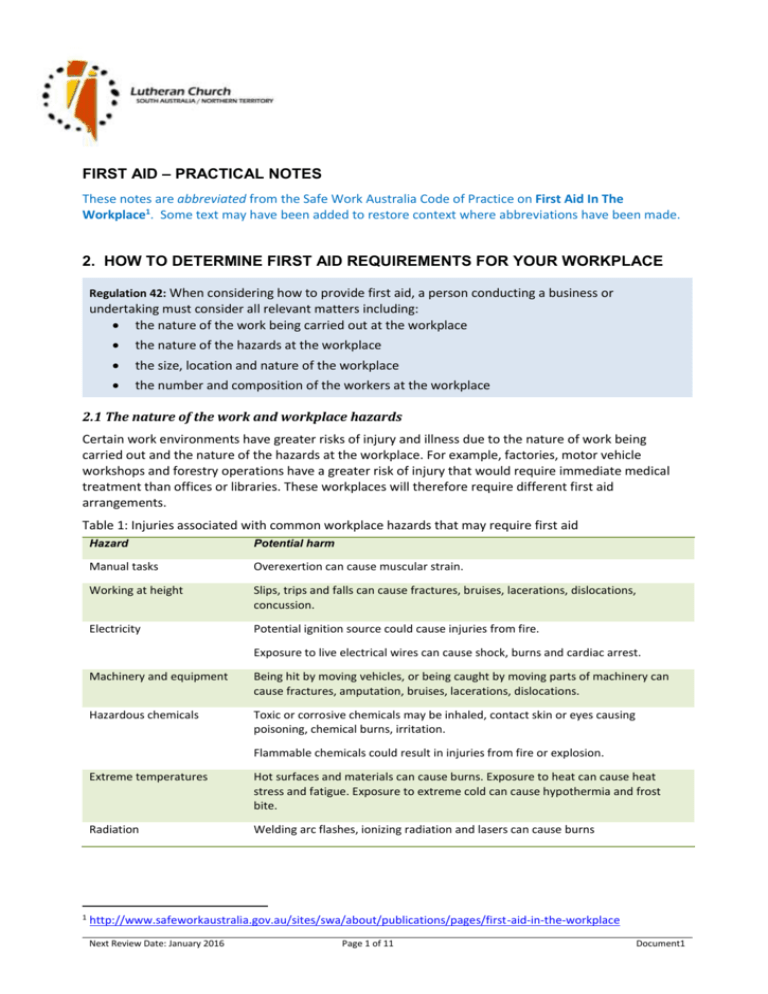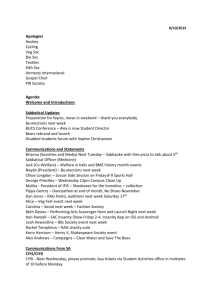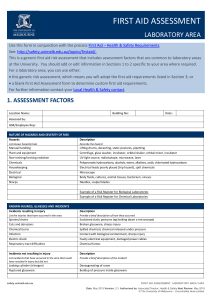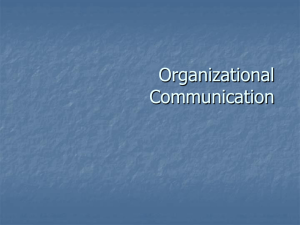First Aid - Practical Notes
advertisement

FIRST AID – PRACTICAL NOTES These notes are abbreviated from the Safe Work Australia Code of Practice on First Aid In The Workplace1. Some text may have been added to restore context where abbreviations have been made. 2. HOW TO DETERMINE FIRST AID REQUIREMENTS FOR YOUR WORKPLACE Regulation 42: When considering how to provide first aid, a person conducting a business or undertaking must consider all relevant matters including: the nature of the work being carried out at the workplace the nature of the hazards at the workplace the size, location and nature of the workplace the number and composition of the workers at the workplace 2.1 The nature of the work and workplace hazards Certain work environments have greater risks of injury and illness due to the nature of work being carried out and the nature of the hazards at the workplace. For example, factories, motor vehicle workshops and forestry operations have a greater risk of injury that would require immediate medical treatment than offices or libraries. These workplaces will therefore require different first aid arrangements. Table 1: Injuries associated with common workplace hazards that may require first aid Hazard Potential harm Manual tasks Overexertion can cause muscular strain. Working at height Slips, trips and falls can cause fractures, bruises, lacerations, dislocations, concussion. Electricity Potential ignition source could cause injuries from fire. Exposure to live electrical wires can cause shock, burns and cardiac arrest. Machinery and equipment Being hit by moving vehicles, or being caught by moving parts of machinery can cause fractures, amputation, bruises, lacerations, dislocations. Hazardous chemicals Toxic or corrosive chemicals may be inhaled, contact skin or eyes causing poisoning, chemical burns, irritation. Flammable chemicals could result in injuries from fire or explosion. 1 Extreme temperatures Hot surfaces and materials can cause burns. Exposure to heat can cause heat stress and fatigue. Exposure to extreme cold can cause hypothermia and frost bite. Radiation Welding arc flashes, ionizing radiation and lasers can cause burns http://www.safeworkaustralia.gov.au/sites/swa/about/publications/pages/first-aid-in-the-workplace Next Review Date: January 2016 Page 1 of 11 Document1 Violence Behaviours including intimidation and physical assault can cause nausea, shock and physical injuries Biological Infection, allergic reactions Animals Bites, stings, kicks, scratches Records of injuries, illnesses, ‘near miss’ incidents and other information that has already been obtained to assist in controlling risks at the workplace will be useful to make appropriate decisions about first aid. You should check the safety data sheets (SDS) for any hazardous chemicals that are handled, used or stored at your workplace. The SDS provides information about the chemical, possible health effects, controls that may be used to reduce exposure and first aid requirements. Manufacturers, importers and suppliers of hazardous chemicals have a duty under the WHS Regulations to ensure that the current SDS is provided to a person at the workplace if the person asks for it. 2.2 Size and location of the workplace In relation to the size and location of the workplace, you should take into account: the distance between different work areas the response times for emergency services First aid equipment and facilities should be located at convenient points and in areas where there is a higher risk of an injury or illness occurring. A large workplace may require first aid to be available in more than one location if: work is being carried out a long distance from emergency services small numbers of workers are dispersed over a wide area access to a part of the workplace is difficult the workplace has more than one floor level Where there are separate work areas (for example, a number of buildings on a site or multiple floors in an office building), it may be appropriate to locate first aid facilities centrally and provide first aid kits in each work area. This may include portable first aid kits in motor vehicles and other separate work areas. The distance of the workplace from ambulance services, hospital and medical centres should be taken into account when determining your first aid requirements. For example, if life-threatening injuries or illnesses could occur and timely access to emergency services cannot be assured, a person trained in more advanced first aid techniques (such as the provision of oxygen) will be needed. 2.3 The number and composition of workers and other people When considering the size of your workforce, you should include any contractors, subcontractors, and volunteers you engage. This may mean the size of your workforce may vary over time. For the purposes of deciding who requires access to first aid, you should consider the maximum number of workers that you may engage at any one time. Generally, a larger workforce requires more first aid resources. You should also consider: the particular needs of workers who have a disability or a known health concern others at your workplace who are not your workers, for example, students in workplaces such as schools, members of the public in places of worship, entertainment or other congregational activities. Next Review Date: January 2016 Page 2 of 11 Document1 3. FIRST AID EQUIPMENT, FACILITIES AND TRAINING 3.1 First aid kits All workers must be able to access a first aid kit, at all times. This will require at least one first aid kit to be provided at their workplace. CONTENTS The first aid kit should provide basic equipment for administering first aid for injuries including: cuts, scratches, punctures, grazes and splinters muscular sprains and strains minor burns amputations and/or major bleeding wounds broken bones eye injuries shock. The contents of first aid kits should be based on a risk assessment. For example, there may be higher risk of eye injuries and a need for additional eye pads in a workplace where: chemical liquids or powders are handled in open containers spraying, hosing or abrasive blasting operations are carried out there is any possibility of flying particles causing eye injuries there is a risk of splashing or spraying of infectious materials welding, cutting or machining operations are carried out. Additional equipment may be needed for serious burns and remote workplaces. The recommended content of a typical first aid kit and information on additional equipment is provided in Appendix C. DESIGN OF KITS First aid kits can be any size, shape or type to suit your workplace, but each kit should: be large enough to contain all the necessary items be immediately identifiable with a white cross on green background that is prominently displayed on the outside contain a list of the contents for that kit be made of material that will protect the contents from dust, moisture and contamination. LOCATION In the event of a serious injury or illness, quick access to the kit is vital. First aid kits should be kept in a prominent, accessible location and able to be retrieved promptly. Access should also be ensured in security-controlled workplaces. First aid kits should be located close to areas where there is a higher risk of injury or illness. For example, a school with a science laboratory or carpentry workshop should have first aid kits located in these areas. If the workplace occupies several floors in a multi-storey building, at least one kit should be located on every second floor. Emergency floor plans displayed in the workplace should include the location of first aid kits. A portable first aid kit should be provided in the vehicles of mobile workers if that is their workplace (for example, couriers, taxi drivers, sales representatives, bus drivers and inspectors). These kits should be safely located so as not to become a projectile in the event of an accident. Next Review Date: January 2016 Page 3 of 11 Document1 RESTOCKING AND MAINTAINING KITS A person in the workplace should be nominated to maintain the first aid kit (usually a first aider) and should: monitor access to the first aid kit and ensure any items used are replaced as soon as practicable after use undertake regular checks (after each use or, if the kit is not used, at least once every 12 months) to ensure the kit contains a complete set of the required items (an inventory list in the kit should be signed and dated after each check) ensure that items are in good working order, have not deteriorated and are within their expiry dates and that sterile products are sealed and have not been tampered with. 3.2 First aid signs Displaying well-recognised, standardised first aid signs will assist in easily locating first aid equipment and facilities. Further information on the design and use of signs is available in AS 1319 - Safety Signs for the Occupational Environment. 3.5 First aiders Regulation 42: A person conducting a business or undertaking must ensure that an adequate number of workers are trained to administer first aid at the workplace or that workers have access to an adequate number of other people who have been trained to administer first aid. Congregations are encouraged to ascertain who has attained any first aid training and obtain their consent to being considered a first aider. Also consider training one or more of your own workers to administer first aid. TYPES OF FIRST AID TRAINING First aiders should hold nationally recognised Statement/s of Attainment issued by a Registered Training Organisation (RTO) for the nationally endorsed first aid unit/s of competency. Apply First Aid provides competencies required to recognise and respond to common life-threatening injuries or illnesses, including life-support using cardiopulmonary resuscitation (CPR), and to manage the casualty and incident until the arrival of medical or other assistance. In low risk workplaces, first aiders are sufficiently trained if they can perform CPR and treat minor illnesses and injuries. NUMBER OF TRAINED FIRST AIDERS The ratio of one first aider for every 50 workers in low risk workplaces is recommended 3.6 First aid procedures You should develop and implement first aid procedures to ensure that workers have a clear understanding of first aid in their workplace. The procedure should cover: the type of first aid kits and where they are located the location of first aid facilities such as first aid rooms (if applicable) who is responsible for the first aid kits and facilities and how frequently they should be checked and maintained the names and contact details of each first aider arrangements to ensure first aiders receive appropriate training arrangements for ensuring that workers receive appropriate information, instruction and training in relation to first aid seeking information when a worker commences work about any first aid needs that may require specific treatment in a medical emergency, such as severe allergies. Information about a Next Review Date: January 2016 Page 4 of 11 Document1 worker’s health must be kept confidential and only provided to first aiders with the worker’s consent how to report injuries and illnesses that may occur in the workplace practices to avoid exposure to blood and body substances – refer to Appendix D what to do when a worker or other person is too injured or ill to stay at work, for example if they require assistance with transport to a medical service, home or somewhere else where they can rest and recover access to debriefing or counselling services to support first aiders and workers after a serious workplace incident. RECORD-KEEPING A record of any first aid treatment given should be kept by the first aider and reported to managers on a regular basis to assist reviewing first aid arrangements. First aid treatment records are subject to requirements under Health Records legislation. PROCEDURES AND PLANS FOR MANAGING AN EMERGENCY Regulation 43: A person conducting a business or undertaking must ensure that an emergency plan is prepared for the workplace that provides procedures to respond effectively in an emergency. The emergency procedures must include: an effective response to an emergency situation procedures for evacuating the workplace notification of emergency services at the earliest opportunity medical treatment and assistance, and effective communication between the person authorised by the person conducting the business or undertaking to co-ordinate the emergency response and all persons at the workplace You may incorporate your first aid procedures into your emergency planning procedures. Emergency procedures should specify the role of first aiders according to their level of qualification and competence. In particular, first aiders should be instructed not to exceed their training and expertise in first aid. Other staff, including supervisors, should be instructed not to direct first aiders to exceed their first aid training and expertise. Further guidance on emergency plans and preparing emergency procedures is available in the Code of Practice: Managing the Work Environment and Facilities. Next Review Date: January 2016 Page 5 of 11 Document1 4. REVIEWING YOUR FIRST AID REQUIREMENTS You should regularly review your first aid arrangements in consultation with your workers to ensure they remain adequate and effective. Check that the people who have responsibilities under your first aid procedures are familiar with them. If the way work is performed is changed, or new work practices introduced, review first aid against a risk assessment to ensure the arrangements are still adequate. Organise a mock first aid emergency to check that first aid is effective. Check that kits and first aid rooms are accessible and suit the hazards that are unique to your workplace. If an incident has occurred that required first aid, evaluate the effectiveness of the first aid that was provided and make changes if necessary. If new information is obtained about a previously unidentified hazard, review the first aid measures you have put in place. The following questions can assist you to review first aid and assess whether improvement is needed: Do the first aid kits and modules suit the hazards at your workplace? Are more first aid kits required? Are first aid kits accessible to workers? Are first aid kits well maintained and identifiable to workers? Is a first aid room or health centre required? Are first aid facilities well maintained? Do first aiders have the skills and competencies required of them and are their skills up-todate? Do workers know how to access first aiders? Are more first aiders needed? Do workers have access to first aiders at all times? Do workers and other people know what to in an emergency situation? Is there easy access for emergency services, such as parking for an ambulance? Next Review Date: January 2016 Page 6 of 11 Document1 APPENDIX A – FIRST AID AND THE RISK MANAGEMENT PROCESS Step 1 – Identify potential causes of workplace injury and illness Does the nature of the work being carried out pose a hazard to people’s health and safety? Have these hazards been identified in work that is being carried out? Has incident and injury data been reviewed? Has consultation with workers and their health and safety representatives occurred? Is specialist or external assistance required? Step 2 – Assess the risk of workplace injury and illness How often does a hazard have the potential to cause harm? What type of injuries would the hazards cause? How serious are the injuries? Does the number and composition of workers and other people affect how first aid should be provided? Could the size and location of the workplace affect how first aid is provided? Step 3 – What first aid is required? First aiders How many first aiders are needed? First aid kits & procedures What kits/modules are needed and where should they be located? Is other first aid equipment needed? Who is responsible for maintaining the kits? What competencies do they require? First aid facilities Is a first aid room or health centre required? Step 4 Review first aid to ensure effectiveness Next Review Date: January 2016 Page 7 of 11 Document1 APPENDIX C – Example of contents for a typical FIRST AID KIT For most workplaces, a first aid kit should include the following items: (Note that this list is a recommendation, not a requirement. To properly consider what your congregation actually requires, use this list in conjunction with Section 3 of the Safe Work Australia Code of Practice on First Aid In The Workplace (abbreviated in the immediately preceding pages of this document). Kit contents Item Quantity Instructions for providing first aid – including Cardio-Pulmonary Resuscitation (CPR) flow chart Note book and pen Resuscitation face mask or face shield Disposable nitrile examination gloves Gauze pieces 7.5 x 7.5 cm, sterile (3 per pack) Saline (15 ml) Wound cleaning wipe (single 1% Cetrimide BP) Adhesive dressing strips – plastic or fabric (packet of 50) Splinter probes (single use, disposable) Tweezers/forceps Antiseptic liquid/spray (50 ml) Non-adherent wound dressing/pad 5 x 5 cm (small) Non-adherent wound dressing/pad 7.5 x 10 cm (medium) Non-adherent wound dressing/pad 10 x 10 cm (large) Conforming cotton bandage, 5 cm width Conforming cotton bandage, 7.5 cm width Crepe bandage 10 cm (for serious bleeding and pressure application) Scissors Non-stretch, hypoallergenic adhesive tape – 2.5 cm wide roll Safety pins (packet of 6) BPC wound dressings No. 14, medium BPC wound dressings No. 15, large Dressing – Combine Pad 9 x 20 cm Plastic bags - clip seal Triangular bandage (calico or cotton minimum width 90 cm) Emergency rescue blanket (for shock or hypothermia) Eye pad (single use) Access to 20 minutes of clean running water or (if this is not available) hydro gel (3.5 gm sachets) Instant ice pack (e.g. for treatment of soft tissue injuries and some stings). 1 1 1 5 pairs 5 packs 8 10 1 10 1 1 6 3 1 3 3 1 1 1 1 1 1 1 1 2 1 4 5 1 Medication, including analgesics such as paracetamol and aspirin, should not be included in first aid kits because of their potential to cause adverse health effects in some people including asthmatics, pregnant women and people with medical conditions. The supply of these medications may also be controlled by drugs and poisons laws. Workers requiring prescribed and over-the-counter medications should carry their own medication for their personal use as necessary. Next Document Review Date: January 2016 Page 8 of 11 Document1 Some types of workplaces may require additional items to treat specific types of injuries or illnesses. Outdoor work If work is performed outside and there is a risk of insect or plant stings or snake bites, assess whether the following items should also be included in the first aid kit: a heavy duty crepe bandage sting relief cream, gel or spray. Remote work Where people work in remote locations, a first aid kit should include: a heavy duty crepe bandage 10 cm (for snake bites) large clean sheeting (for covering burns) thermal blanket (for treating shock) whistle (for attracting attention) torch/flashlight. The appropriate contents will vary according to the nature of the work and its associated risks. Burn injuries If your workers are at risk of receiving burns, you should include the following items: burn treatment instructions on two water-proof instruction cards: one for the first aid kit and the other to be located on the wall next to the emergency shower or water supply hydro gel (8 × 3.5 gram sachets) hydro gel dressings clean polythene sheets (small, medium and large) 7.5cm cotton conforming bandage. Next Document Review Date: January 2016 Page 9 of 11 Document1 APPENDIX D – Standard precautions for infection control First aiders should take standard precautions to avoid becoming ill and exposing others to illness when handling blood or body substances. Standard precautions are work practices that are applied to all patients and their blood and body substances, regardless of their infectious status, to ensure a basic level of infection prevention and control. Standard precautions include hand hygiene, use of personal protective equipment, appropriate handling and disposal of sharps and waste, cleaning techniques and managing spills of blood and body substances. Providing first aid safely Before providing first aid to an injured or ill person, first aiders should assume they could be exposed to infection. First aiders should wash their hands with soap and water or apply alcohol-based hand rub before and after administering first aid. First aiders should also wear personal protective equipment to prevent contact with blood and body substances, including disposable gloves. Eye protection, a mask and protective clothing may also be necessary if splashes of blood or body substances are likely to occur. You should establish procedures to avoid workers becoming ill and exposing others to illness when handling blood or body substances. Procedures could include: proper hand hygiene practices how to handle and dispose of sharps how to clean surfaces and reusable equipment how to manage spills and handle and clean soiled laundry how to handle and dispose of waste when to use personal protective equipment, for example, using resuscitation masks for cardiopulmonary resuscitation. First aiders should be aware of what to do if they have accidental contact with blood or body substances, a sharps injury or contact with a person known to have a contagious illness. Any part of the body that comes in contact with blood or body substances should be washed with soap and water immediately. Prompt medical advice should be obtained. All first aiders should be offered hepatitis B virus vaccination. Contaminated items All items that are soiled with blood or body substances should be placed in plastic bags and tied securely. Waste disposal should comply with any state or local government requirements. Sharps, including scissors and tweezers, that have become contaminated with blood or body substances should be disposed of in a rigid-walled, puncture-resistant sharps container by the person that used them. The materials, design, construction, colour and markings of sharps containers should comply with: AS 4031-1992 – Non-reusable containers for the collection of sharp medical items used in health care areas AS/NZS 4261-1994 – Reusable containers for the collection of sharp items used in human and animal medical applications. If a first aider sustains a sharps injury or thinks they are at risk of infection from blood or bodily fluid contamination, they should seek prompt medical advice. Next Document Review Date: January 2016 Page 10 of 11 Document1 Cleaning spills Cleaning should commence as soon as possible after an incident involving blood or body substances has occurred. First aiders should wear disposable gloves when cleaning spills and if splashes of blood or body substances may occur, additional protective equipment such as eye protection, plastic aprons and masks should be worn. Surfaces that have been contaminated with blood or body substances should be wiped with paper towelling and cleaned with warm soapy water. It is generally unnecessary to use sodium hypochlorite (chlorine bleach) for managing spills but it may be used in specific circumstances, for example if the surface is hard to clean. Next Document Review Date: January 2016 Page 11 of 11 Document1






